NO EXECUTE!
(c) 2020 by Darek Mihocka, founder, Emulators.com.
April 22 2020
Earth Day at 50 - Adapting is not enough
Today is the 50th anniversary of Earth Day. Almost as soon as the post-WWII economic boom began our parents' and grandparents' generations realized we were destroying the planet. We've known now for 50 years yet done little because it is always the next generation's problem just like the myth of space tourism is just a few months away.
As more than half the planet's population is under lockdown, and it has become all of _our_ problem, may I ask when was your last day of civilization as you knew it? For me it was Monday March 9th.
That was the day that I last flew in an airplane, last drove a car through the city. 24 hours earlier I was leaving a sunny beach near Cancun to board a flight back to Seattle. Except Alaska Airlines was mysteriously cancelling a lot of flights into Seattle and I ended up grabbing a layover in Houston. That morning in Houston, Bush airport was full and bustling. People were joking about this media scare about some virus.
I've been a germophobe of late anyway so I was paranoid enough the trip that my wife and I had packed several small bottles of hand sanitizer, just in case.
I left Houston watching down at a city full of traffic and bustle. Life still seemed normal.
A few hours later I landed in Seattle in what should have been the start of evening rush hour. Traffic in Seattle has been awful for years what with the explosive growth of hometown companies such as Microsoft, Amazon, Boeing, Starbucks, and new campuses from Silicon Valley giants such as Facebook and Google. Morning rush hour begins around 5am and runs until noon, there is a brief moment of light traffic over lunch, and then it all picks up again for evening rush hour around 1pm.
Yet as I looked down that Monday afternoon the highway almost empty. You would have thought it was 7am on a Sunday morning or something.
There were hardly cars on the roads, no boats on the water, no other planes in the sky, not even the usual smog in the air. Seattle had already been shut down for almost a week.
The modern civilization I had known since leaving college 30 years ago was over.
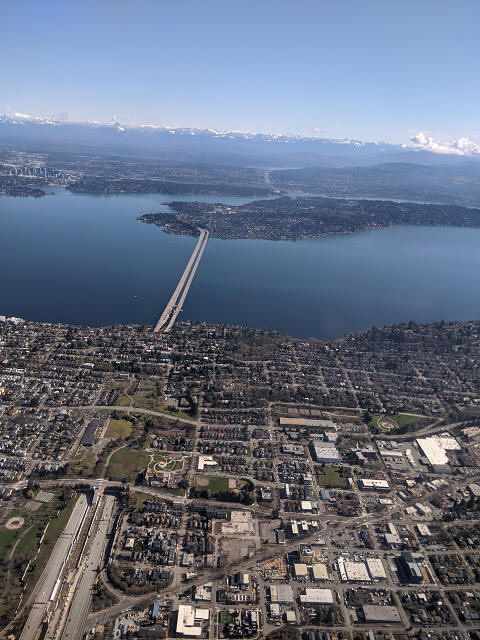
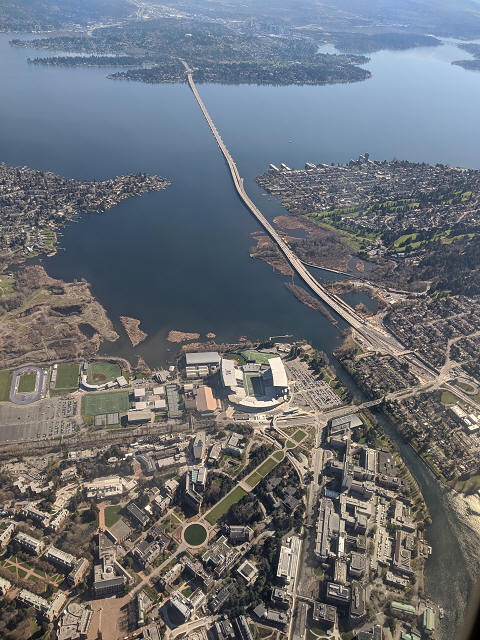
If you had asked me 6 months ago I would have answered we have until 2030, maybe 2040 top, 10 to 20 years to fix the planet before society is completely transformed by economic collapse, climate migration, sinking cities, lack of drinkable water.
What did catch me so completely off guard on March 9 is just how fast our old civilization ended. Billions of us are now in our homes like modern day lepers, not going to work, not travelling, being very careful and suspicious of each stranger we now pass at the grocery store.
A lot of people are starting to get cabin fever. They want to get out, get back to work, go back to life as it existed before. Yes, humans are great at adapting to adverse situations. But we need to do more than adapt and exist, we need to transform our circumstances into the world we want. Now it is absolutely critical we not go back to our old post-WWII ways.
It's not just about the climate changing. Birds and insects are in decline. Our entire food chain could potentially collapse on us well before the heat kills us.
A decade ago I watched Al Gore's movie "An Inconvenient Truth", and as a subscriber for the past 25 years I have read the cover stories in National Geographic of melting ice caps and ozone holes and the damage this will do to humanity by the year 2100. As I look through the past issues I realize they have been running stories about this since the 1990's, we've known for decades what was coming. Well obviously, people were concerned enough 50 years ago to create Earth Day in the first place. President Richard Nixon of all people had the foresight to create the Environmental Protection Agency 50 years ago.
The August 1997 issue of National Geographic has a story about America's Barrier Islands, the long stretch of thin islands stretching up and down the eastern seaboard and gulf.
The term "global warming" already appears in that issue, that sea levels were rising 6 inches per century at the time was known. That millions along the east coast would eventually be displaced was known.
Yet developers in Florida and elsewhere have just kept building.
The February 1995 issue of National Geographic shows this photo of a slightly flooded Venice, what by today's standards is nothing compared to the feet deep flooding they had recently.

Yet 25 years later Miami and Venice keep sinking into the water. They adapt by raising sidewalks, putting up sandbags, tolerating flooded streets, all for that mighty tourist dollar. What we see happening in those cities will happens hundreds of other coastal cities eventually. Historic "100 year floods" are occurring annually. Millions if not hundreds of millions of human beings will be affected and displaced by rising sea levels. Which we now know are accelerating at much more than 6 inches per century. The rate has doubled to over a foot per century.
What seemed like a catastrophe for the year 2100 for our great-grandchildren to fix has become something that will affect _us_ in our lifetimes. It _is_ affecting us. Pathogens from animals - Mad Cow, SARS, Ebola, MERS, swine flu, bird flu, H1N1, Zika - spread from close contact with wild animals or eating infected animals. Each is eventually contained because each pathogen was not quite ideal. In the case of Ebola it kills people too quickly before they can spread it far. Others are not easily transmittable. Mad Cow you have to eat the animal meat. covid-19 is the perfect storm of a virus that is airborne, is infectious before symptoms appear days to weeks later.
It is the type of virus that Hollywood movies and scientists alike have warned us would spread one day. Bill Gates warned us about it in a 2015 Ted Talk.
The television series "How The World Ends" had a Pandemics episode in 2017 that studied the SARS outbreak of 2003 and projected what would happen if a similar more infectious virus appeared today. It practically describes step-by-step the covid-19 outbreak of 2019. I remember watching that episode last year and not taking it seriously, thinking this couldn't really happen in my lifetime.
As the 2010's Decade Of Disruption progressed the warming sped up, the models were adjusted and started bringing in the date, 2070, then 2050, then alarms about 2030.
Major tech companies such as Apple, Google, Microsoft, are vowing to go carbon neutral. As Australia was burning in January 2020, Microsoft vowed to go carbon negative by 2030 and eventually erase its carbon emissions of the past 40 years.
At the start of 2010 I was driving a V6 Ford Mustang, a V6 Chevy Blazer SUV, and ate steak probably 3 or 4 times a week. I didn't think I was doing anything wrong. That's what most of us did.
At the start of 2020, my own life has entirely changed over the past decade, my own buying habits, driving habits, eating habits have changed. I drive electric cars, I have gone vegan (plant-based) and stopped eating meat, and I go out of my way to not shop online.
It took me the better part of the past decade to disrupt my habits and transform my way of thinking and my actions.
As I've said before, I am not a "tree hugger". Ten years ago I thought vegetarians were crazy. But one cannot deny that over the past decade humanity has declined. We lose sleep as we stare at our devices at night, we are more stressed, we spend even more time in traffic than before. More food is produced today than needed to feed the planet yet homelessness and hunger is still around. People are addicted to pain medicines. Suicides are up. Obesity is itself an epidemic. Life expectancy is down. This is not the future we want, is it?
We are not living the Star Trek or Jetsons future we might have imagined last century watching those shows as kids. To achieve that we have to transform society and let go of old habits. It will not be overnight, people will grumble, but either we do it based on rational thought, or we'll be forced to do it when the next pandemic or disaster hits.
Three weeks ago I made some calculations based on the spread of covid-19 cases in March and projected at the low end about 80000 Americans will be dead of covid-19 by end of this month if we slow the rate. And if we don't and it keeps spreading at the rate it did in March then 2 million would be dead.
As I write this today on Earth Day the total has already passed 47000 (where just three weeks ago it was passing 3000). My worst case trend line showed 50000 deaths by Easter. That thankfully has slowed, but 50000 Americans will have died of this virus by tomorrow night instead. That is not success, we just slowed the curve a week and a half. The numbers are still on track with my "best case" low estimate of 80000 dead by May 1 and earlier today we are warned that if we stop isolating too soon we will likely see a second spike far worse than the current one.
And yet it amazes me how badly (and stupidly) people just want to go back to the old way of life, to go back to the beaches, to the bars, to the movie theaters, to all the places this virus will spread. We _can't_ just blindly do that without changing our ways first, and for sure stopping the spread. The world is only getting more crowded, more populated, these pandemics will come again.
Humanity's Fatal Flaw
Human beings have a fatal flaw: we procrastinate. We tend to be lazy and put things off that are not imminently urgent. We wait until a bill is due to pay it. We wait until we are driving on rims before we put air in our tires. We wait until that toothache becomes unbearable before we go to the dentist and which then turns into a surprise root canal. (I'm guilty of all of these!)
Even though all of us watched the news a few months ago and saw that China had locked down 50 million citizens most of us though of it as China's problem and went about our business. We saw Italy get locked down and still we didn't think to proactively do it elsewhere.
As comedian Bill Maher and others point out we freak out about a plane crash thousands of miles away, because we envision how it randomly could have been us, but we ignore the tens of thousands of deaths each month that occur from cancer, heart disease, stroke, suicide, drunk driving. Because those of us who aren't imminently dying of cancer or suffering a heart attack tell ourselves we'll quit smoking tomorrow, we'll eat one more greasy burger and then go on a diet,
we convince ourselves that we're better at texting and driving than other people. We'll all die eventually but many of these deaths are premature and preventable in terms of these people could have lived several more years if they had healthier lifestyles.
There is an asteroid Apophis hurtling toward Earth that will graze us in October 2028, probably not hit the planet directly but who knows, yet most people are completely oblivious to this potentially life ending asteroid collision in 8 years.
Most of us will likely only start to worry about it when we look up and see it visible to the naked eye.
To their credit here in Seattle our tech employers Amazon Microsoft and others sent thousands of us home in early March and still idiots like me hopped on a plane to spend a weekend in Cancun. I had my doubts because surely they would have shut down the airports? Airlines and politicians unfortunately did not close the airports in time.
Sweden I think to this day still has not locked down the country as thousands are dying there, much more than neighboring Scandinavian countries. How could the country that brought us ABBA and Volvo be so stupid?
For everyone who thought building spaceships and flying off into space is the answer I have bad news. That's still science fiction. There is not the time, money, or resources to build enough space ships to put humanity into space quickly enough. After 20 years SpaceX has still to launch a single paying customer into orbit even though that is always said to be just a few months away. So I am not a Musketeer and thus I also refuse to buy a Tesla. This is not Wall-E where we fly off in giant cruise ships while the planet becomes a garbage pit.
And besides, if the past few weeks of home isolation has taught people anything, most of us are not cut out for the isolation of deep space travel. If you can't even sit still in your apartment with your Xbox and your Netflix and your YouTube and your food deliveries for one month, how would you survive 8 months of cramped quarters getting to Mars? This is a reality check for all the wannabe Martians who want to volunteer for an 8 month flight and years of isolation when you get there.
We have to solve the problems facing the planet, well, _here_ on the planet.
Parallel Futures On Display
February 2 2020 was "Palindrome Day", a quirk of the calendar where written as 2020/02/02 or 02/02/2020 the date is a mirror image of itself. The 0202 portion represents Groundhog Day where just like in the movie we can keep repeating our mistakes over and over as Bill Murray did. The 2020 side is hindsight, to look back at the mistakes of the 20th century and learn to not repeat them. In the movie Groundhog Day, Bill Murray's character eventually does clue in, but only after how many hundreds of failures.
It is just a date, but it reminds that we have a choice to brute force adapt, or think and transform on purpose. We are at a "blue pill / red pill" moment like when Neo wakes up in the movie The Matrix. Go with the blue pill and cling to the blissful ignorance of the 20th century, or, choose the red pill to wake up and create a new future.
The former option is merely adapting to our dire situation, like putting a bucket under a leaky roof, the latter option is to accept the truth and choose to replace the roof. For example, merely raise the sidewalks higher in Venice rather than stopping rising sea levels in general.
Because of this crazy covid-19 shutdown, we are experiencing an unexpected superposition of two alternate realities that are presenting themselves to us simultaneously. We can able to see and visualize the consequences of both blue pill and red pill choices
We ended 2019 with record stock market, record oil production, record corporate profits, record tourism. The world was going 100 miles-per-hour and just wanted to go faster. Cities were flooding, storms were getting more severe, Greenland and Australia and the Amazon were on fire. That is the universe we lived in and didn't seem to want to change because it all matters about making more money and more profit than the year before, at all costs.
However, this covid-19 outbreak has put the fear of imminent danger into our minds. Suddenly billions of us _did_ what no Al Gore movie could make us do - we stayed home, we didn't go to work, we stopped driving, we cut down on our pollution.
In effect we have opened a glimpse into a parallel universe, one where we listened to Al Gore, one where nations all over the world adhered to climate change treaties and then some, one where we cut our oil usage, reduced our carbon emissions, reduced our pollution and cleaned up our air, and got rid of rush hour gridlock. ALL IN A COUPLE MONTHS!
For this brief period we are witnessing what a clean planet can look like. The daylight is brighter these days, the sunrises more vivid.
My wife and I walk (not drive!) around the city these days. We have been marveling these past few weeks at how beautiful everything looks without so many people around.
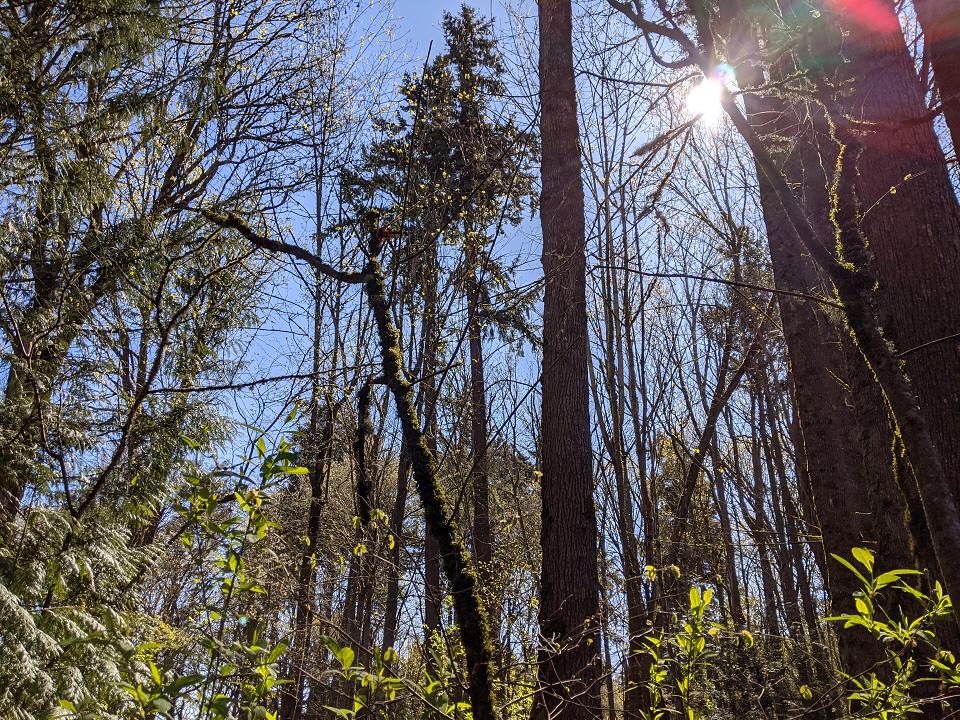


above: clear skies over Seattle. What do you notice missing? Smog yes, but also, no airplane contrails. The sky is free of human artifacts.
photo credits: Janelle Poole
People elsewhere all over the world from Europe to Asia are seeing clear skies and mountains for the first time in years.
Never in my lifetime did I expect to see oil prices plunge to decades old lows, even go negative as happened this week. Demand for crude oil is so low they're giving it away.
Car accidents are down. Crime is down. Despite the failure of candidates such as Andrew Yang to convince voters for a Universal Basic Income of 1000 dollars per months, the U.S. government is now doing exactly that. Checks are being mailed out to many people and small businesses.
Meat packing plants are being shut down. Dairy companies are going out of business as milk is being dumped in fields, a trend that was already happening before covid-19. While that is one-time waste, it is good for the planet to reduce the amount of livestock. Over 50 billion of animals are killed every year at tremendous cost to the environment. Just as tobacco farmers successfully diversified to other more useful crops, so can dairy and livestock.
The handshake is dead. Good riddance, I always hated when someone would shake my clean hands just as I sat down at a restaurant.
Not every consequence of this lockdown is a bright and rosy environmentalist's dream.
For example, my apartment in downtown Seattle that I've had since going to work for Amazon in 2010 is in a building that has about 50 units. These are studio apartments and one-bedroom apartments, so let's say average two people per apartment, 100 people in the building. Even before the lockdown in normal times I was amazed every single week when I carried the garbage and recycling down to the garage just how much waste a hundred people produce. One delivery box after another used once and then dumped into the recycle bin, or worse, left on the concrete floor to get dirty and tainted. Very little of this cardboard waste actually gets recycled and reused, most of this cardboard is tainted with liquids and dirt and labels and other things that people did not remove. So this all goes to a landfill. It's disgusting how wasteful we are even in normal times. Now, that everyone is sitting at home waiting for food and toilet paper deliveries these deliveries are piling up in the hallway. People, come out of your apartments and pick up your damn deliveries!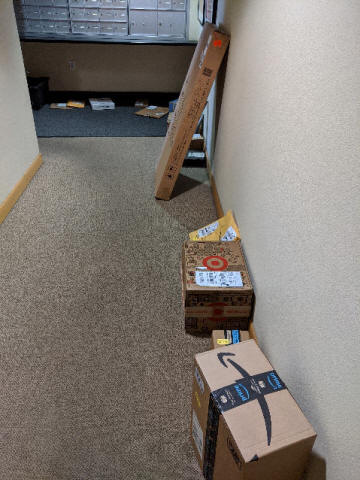
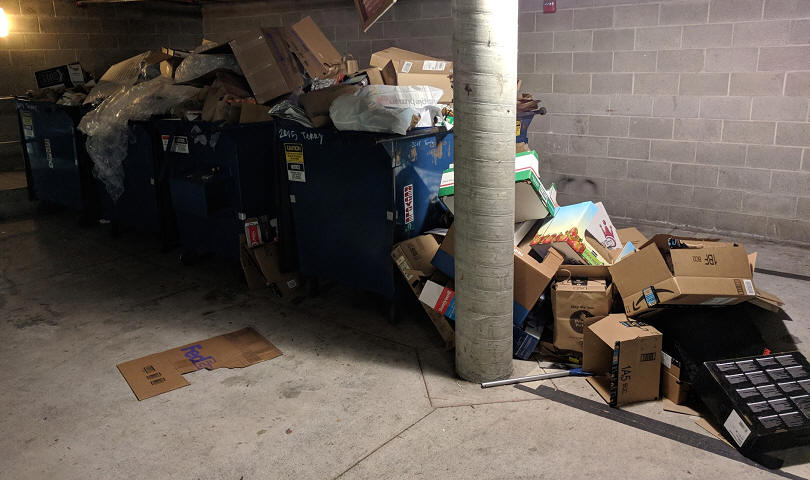
above: garbage in, garbage out. the glamor of downtown Seattle condo life. :-(
This lockdown has also shown us who the true vital workers in our society are - truck drivers, delivery people, grocery store clerks, farmers, laborers, doctors, nurses - ironically most of these are some of the most underpaid and overworked workers in our society the ones who need a Universal Basic Income the most.
Those of us who are cocooned at home are probably realizing that most of our jobs are complete, well, bullshit! Ok, "non-essential" more polite? If our jobs are such that we can do them from our couch chances are we probably are not that important in the grand scheme of things (people who develop Atari 800 emulators included).
And that's the reality of today's global economy. A small percentage of workers produce "stuff", move "stuff", deliver "stuff" that we need to live. The rest of us are just bloated meat bags who consume the "stuff".
I've worked in Xbox at Microsoft which means I've contributed to people wasting their leisure time. I've worked on cloud gaming at Amazon Web Services, so again, I've contributed to people's sloth. I've written Atari emulators and kept updating them for 30 years leading people to, yes, waste more time. :-)
Most of the global economy - from air travel to hotels to restaurants and bars to spas to concerts and movie theaters to sports and casinos and video gaming to comic book conventions and art galleries - is just a pure leisure time money sink of disposable income. It moves money around, it keeps people employed, it entertains us, but it does not actually produce anything of substance. Football games are little more than an exercise in selling as much beer to 70000 people in a three our span.
By the way, am I the only to notice that there have been _zero_ beer commercials on television this month. I like it!
Sloth and waste is fine I guess when resources are seemingly unlimited, such as 200 years ago when the world population was 1 billion people and there were ample continents to plunder. But our pursuit of leisure activities is needlessly wasting resources in an over-crowded over-populated planet on nearly 8 billion who burn through more energy per-capita than 200 years ago.
And it's not because immigrants are taking our jobs. As candidate Andrew Yang pointed out, most of the America's rust belt jobs are being lost to robots, not foreign workers. Warehouses that provide those items you have shipped to your doors are using more and more robots and fewer and fewer humans. Technology itself is helping to eliminate our jobs. Automation makes more and more of our mundane jobs expendable. Not soon, but perhaps in a few decades even those necessary jobs will be replaced by self-driving trucks and robots.
As an aside, "self driving" anything scares the hell out of me. The same way Dr. McCoy hates using the transporter, I cannot envision a day where I allow a hands-free automated self-driving car to take me around at highway speeds knowing what I know about how software is written. Besides, driving is too much fun.
This quantum physics-like dual reality that we are getting to witness, this glimpse of an alternate future, will not last forever. Corporations and governments are eager to re-open businesses and global markets. While a true UBI would have cost the U.S. government 4 trillion dollars a year (but reaped many benefits in terms of lowering other costs to society) the government now has already spent more than that in quick bailouts. While the emissions are lower and air is getting cleaner, airlines and car companies can't wait to start polluting again. They are eager to spin the economy back to 100 miles-per-hour and faster.
And that's the sad truth that if we simply all willingly go back to normal we're dooming ourselves for another collapse of society. I don't think we are ever going back to "normal" normal. Just as 9/11 forever made us have to take our shoes off at airport security and take out our laptops, aspects of social distancing will remain for a long time. We will always be dubious now of each new person we meet and shake hands with (or perhaps the handshake will remain dead?)
I am not an idealist, I am _not_ saying "shut down the airlines, shut down fossil fuel companies, close the hotels, ban everything!" Not at all. We can't get rid of oil, it's not feasible (more on that below).
For one thing how would an all-electric airplane fly at close to the speed of sound as jumbo jets do today? An electric motor powering a propeller cannot achieve such a speed because the blade tips would break the sound barrier, much like the problem of cavitations on submarine propellers. Bio-fuel is perhaps the answer. Some sort of hydrocarbon based propulsion will need to remain, the energy density of lithium-ion batteries is an order of magnitude too low to replace gasoline and other fuels for long trips.
One reason I never supported Bernie Sanders and his message: he sells false hope for the wrong problem. He wants to throw money at treating the symptoms, not solve root causes. Bernie talks about paying for drugs and lowering drug costs so we can all remain drug-addicted prescription pill-poppers. He faults drug companies for providing products people demand. He does not hold people accountable for their poor lifestyle choices in the first place.
Music, art, entertainment, socializing with each other, that's what makes us human. We need those have those leisure time activities, that interaction and exchange of ideas.
The answer is _not_ to "hit Pause" and shut down the world economy forever. That's not sustainable, society would collapse back to the Dark Ages. We would not be human. Bernie Sanders' dream of cheap drugs and shutting down corporations is wrong.
The answer is also not to take the blue pill of reliving the past glory of 20th century maximum overdrive economic growth. That _will_ lead to societal collapse in 2030-2040 by means of more pandemics, rising sea levels, pollution, shorter life spans.
The red pill answer, the sustainable answer, is to use our hindsight to create the sustainable future we want to enjoy, which means to all... slow.. the fuck... down!
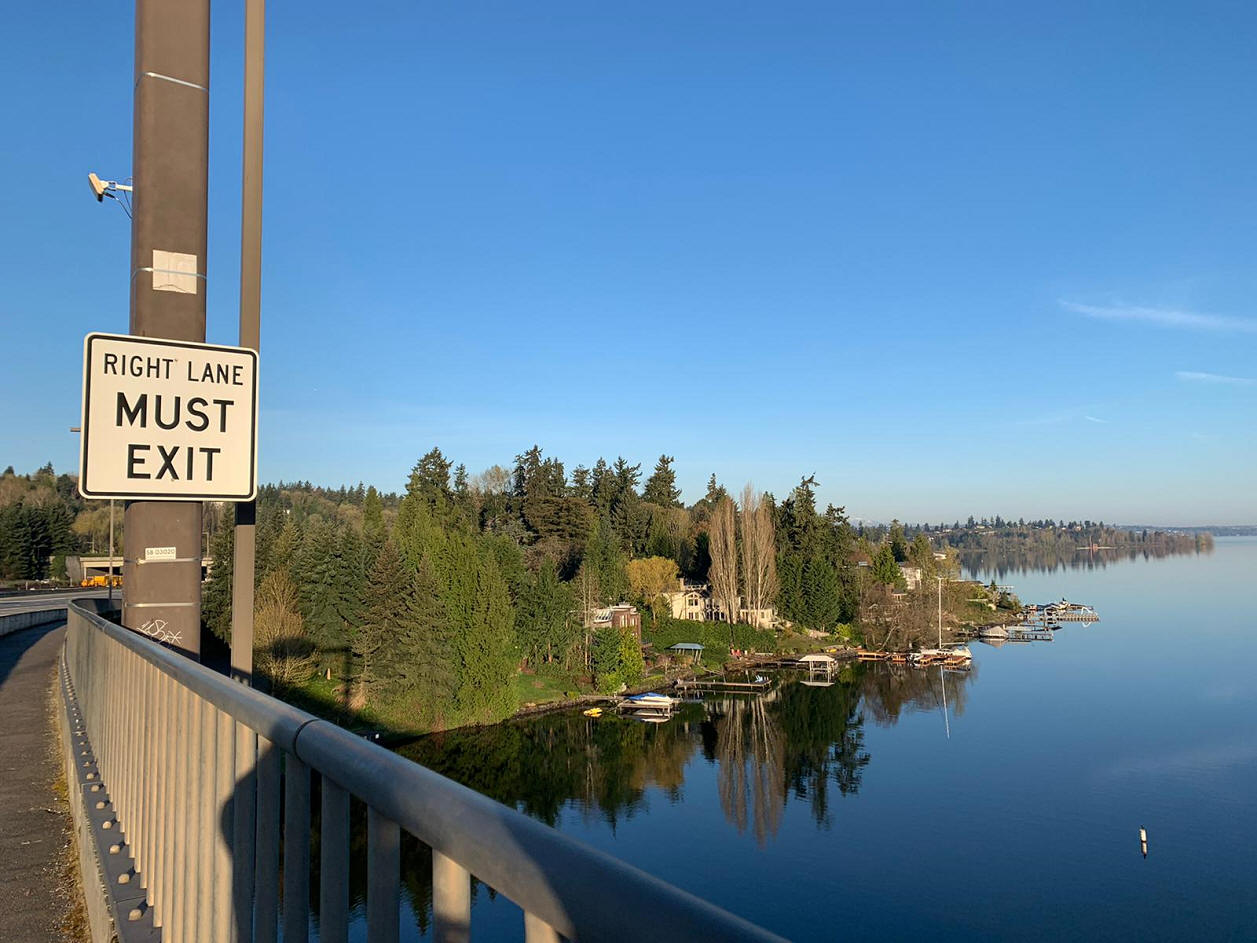
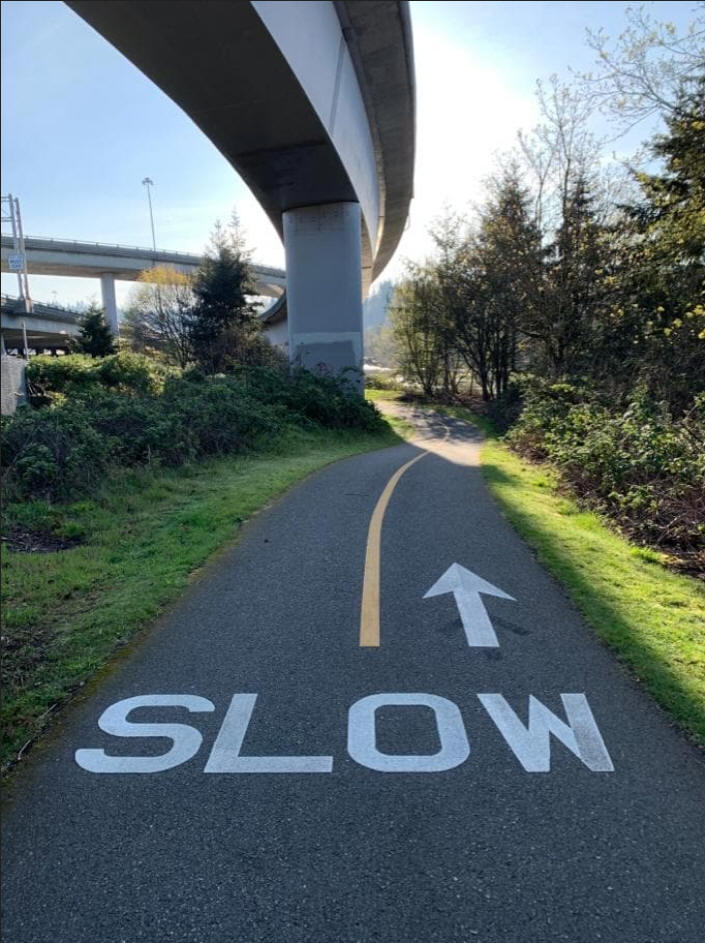
photo credits: Janelle Poole
We need to take the highway off ramp out of the fast lane and slow our roll. Travel less. Drink less alcohol. Eat less meat. Put down that third pizza slice. Drive electric when you can. Even better, walk to the store instead of taking the minivan! It is up to every single one of us to be responsible for our healthy choices and our environmental choices.
Billions of us were scared enough of covid-19 to willingly shelter at home these past few weeks, we can collectively choose to address climate collapse, pollution, waste. _We_ did that.
Don't wait for governments to tell us what to do, don't wait for corporations to take the lead, as many of them even during this outbreak are just spamming me to spend more money on more "stuff". I'm still getting spammed by airlines with cheap airfare offers during this lockdown. Even the beer companies were wise enough to pull their beer ads for a while. Kudos to the beer companies for having some common sense.
My own "Decade of Transformation"
My background is in electrical and computer engineering. I like to tinker, since junior high school when I would take old radios and televisions apart to the 20 years I've been building my own PCs and blogging about do it yourself hardware tinkering. I've written about the clock speed ceiling that CPUs hit about 20 years ago, the single-core performance wall, which has led to a transformation in CPU design from single large high clock speed CPU cores in 2000 to the multitude of multi-core low-power CPU cores we see today in everything from phones to iPads to Windows laptops.
My career choice in emulation and compilers has made optimization a necessary trait of my work. It is not simply sufficient to write some code or build a functional piece of hardware. Anyone can do that.
In 1982 when I was a high school student playing around with my Atari 400 it bothered me that the graphics were slow. You could see a dialog line of pixels get drawn by the DRAWTO command. So I did something about it, I learned 6502 assembly code and wrote my own set of graphics utility functions. Three years later at 18 years old I got paid by ANTIC magazine which published my code. I learned optimization can be profitable, not just useful.
A year later taking engineering in college away from my Atari 400 I wanted to keep running some old games such as Star Raiders and Lode Runner. I didn't have those on the college PCs, or on the Macs, or even on my new Atari ST. So I wrote an emulator which I called "ST Transformer", later shortened to "Xformer" for the electrical schematic notation.
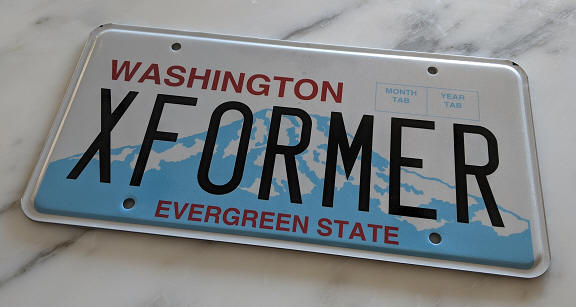
An electrical transformer converts voltages. Inside of a power supply it can be combined with diodes and capacitors and voltage regulators to convert AC current to DC current. I thought of an emulator that translates Atari 400's 6502 machine code to the Atari ST's 68000 machine code as a form of "software transformer". I have spent over 30 years since then developing or working on over a dozen more software transformers - emulators and virtual machines of all kinds.
Storage and lighting
My urge to tinker and optimize things did not just end there. Over a decade ago I did this blog posting http://www.emulators.com/docs/nx22_flashfwd.htm about flash memory and building your own homemade SSD (solid state drive). I soon replaced most of my hard drives in all my Macs and PCs with flash-based SSDs. Again, a win-win of lower power consumption and faster performance.
I began experimenting with LED bulbs in 2011. I purchased a few early generation LED bulbs at Home Depot and Fry's Electronics and tried a few around the house. They were bright. They were cool to the touch. And you could drop them without harm! But they didn't work dimmers (they just flickered), and many of the bulbs at the time were larger than a standard light bulb.
By 2014 this had changed, and I remember doing a Home Run to purchase about 80 LED bulbs to replace almost every single incandescent and mini fluorescent bulb in the house and have spares. In the 6 years since I did that not one single LED bulb has needed replacing.
At the times, both flash memory and LED lights were a pricey options compared to what they were replacing. Flash memory used to cost over $4 per gigabyte. LED bulbs cost $25 or more. Today, SSD capacity costs under 20 cents per gigabyte, in many cases under 10 cents per gigabyte. LED bulbs around a dollar each now and work well with dimmers.
Even USB thumb drives, especially the latest USB 3.1 based flash drives such as these from Samsung, are ridiculously fast. I'm getting about 100 megabytes/second write speed and double that read speed from these $40 thumb drives.
SSD storage and LED light now in high sight are a no-brainer, we all use them. Cities have replaced traffic bulbs with LED lights. Desktop computers and cloud servers now use SSDs. The smartphones, iPads, Android tablets, Macbook Air, and Windows 10 on ARM64 based laptops today owe their light weight, small size, and long battery life to the combination of SSD drives and LED backlights.
Nobody that I know is arguing that we bring back incandescent lights or CRT monitors. Society has in part lowered its energy consumption with these transformative technologies.
Recycling of e-waste
Over 10 years ago, the news show "60 Minutes" ran a piece called "The Electronics Wasteland" on the ugly side of recycling electronic waste (such as the old hard drives we were throwing out to replace with SSDs). We love to buy devices and throw away old ones, but where does that old hardware go? As 60 Minutes showed, much of it goes overseas to places like China or India where it is picked apart in very terrible and dangerous conditions. It isn't just magically melted down at the local Radio Shack and turned into new electronics.
Me personally, I try to buy a lot of recycled electronics and recycle my old computers motherboards locally at places such as REPC in downtown Seattle. It is where I acquired a lot of my old Macintosh computers that I used during the development of SoftMac. It is also where more recently I picked up some beautiful 24- and 28-inch iMacs that I use as Windows 10 selfhost machines. Perfectly good usable hardware someone else decided just wasn't cool enough for them.
But much of the e-waste doesn't get recycled and reused like this, it does end up in the landfills of Asia.
My old friend Ignac Kolenko from our days at University of Waterloo and Branch Always Software has been involved in electronics recycling. He gave me a tour of his facilities last summer 2019 at Conestoga College when I was back visiting in Toronto that week. He showed me machines that he and his students are developing that sort and dismantle old electronics such as old hard drives. Much like the "Mr. Fusion" device in "Back To the Future", throw in waste and one end and it goes down a conveyor belt through various machines and out come recycled electronics. Well, that would make it a "Mr. Fission" I guess, but you get the idea. Much like the off-the-grid local power generation of Mr. Fusion, this is local and safe recycling of electronic waste.
I've invited Ignac to write a little blurb here to explain more, take it away Ig...
At Conestoga College, our SMART Centre, headed by executive director Ig Kolenko, collaborates heavily with Dr. Hamid Karbasi, Conestoga’s NSERC Industrial Research Chair responsible for research into advanced recycling technologies for electronic waste. In 2016, the world generated 49 million tons of eWaste, with an estimated 60 million tons by 2021. Only 20% of this eWaste is properly recycled, leaving the remainder to be plowed under in landfills.
Solutions developed with our recycling industry partners include robotic dismantling of CRT monitors / TVs, flat panel displays and hard disks, to help retrieve valuable commodities for use in circular economy solutions. In addition, solutions to help sort all the plastics and other commodities used in electronics products, to clean the waste stream after electronics are shredded in the recycling process, are being developed, leveraging hyperspectral camera technologies, terahertz wave technologies and AI / machine learning algorithms to detect the presence of desired objects in waste streams and effectively recover this material for recycling. This is needed because eWaste is the fastest growing solid waste stream in the world, and existing recycling processes and infrastructure cannot keep up. It’s unsustainable to continue in a take-make-waste linear economy – we need to switch to circular economy models where products at end of life can be reused / refurbished, repurposed, and effectively recycled into new components needed for the supply chain. The SMART Centre works on applied research with industry partners in sustainable design of new products – improving battery life of electronic devices to extend lifetime of products such as IoT sensors and better design for future recyclability are two key areas of activity. As jurisdictions like Ontario move towards producer responsibility for the end of life of products a company manufacturers, it is hoped that products will be redesigned for greater sustainability and recyclability and slowly move towards a circular economy model.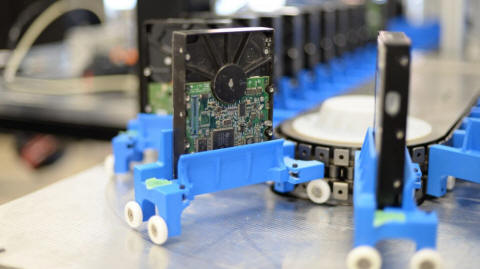
A general article about the recycling research is here: http://blogs1.conestogac.on.ca/news/2019/12/delivering_solutions_through_a.php
Computing
When I worked at Amazon Web Services I learned all about the need to conserve power in the datacenter. Every little unnecessary component you leave on a motherboard ends up wasting electricity and in turn generating heat. That heat then requires cooling which in turn uses more electricity by means of spinning fans or air conditioners. Does a server board really need a sound chip? A floppy disk controller? Those just waste power. This is why most datacenters now use custom designed hardware which eliminates these unnecessary generic components. The use of SSDs over mechanical rotary hard drives, while slightly more expensive, saves energy usage and money over the life of the server.
For similar reason I stopped building desktop PCs in 2015. A Skylake based Core i7-6600 system that I built in August 2015 was the last time I purchased a motherboard and a CPU. People have sent me email over the past 5 years when I am building another system and reviewing it, and the simple answer is that for my purposes the giant desktop PC tower is dead. Other than a handful of old Core 2 and Core i7 systems that are 5+ years old at this point, every single "desktop computer" I use today is actually a touch-screen tablet or laptop of some sorts.
As I blogged about before I was an early adopter of the OLPC laptop over 10 years ago, the IBM Thinkpad Android tablet in 2011, the Surface RT table in 2012, the Surface Pro in 2013. In 2011 I did a posting about the new category of "Ultrabook" laptops http://www.emulators.com/docs/nx34_2011_avx.htm whose characteristic featured touch screens, SSD drives, and thin form factor. But none of those devices were true desktop replacements, as either they didn't run Windows Pro, they had flimsy keyboards, the screens were too small, or the memory and storage was too small.
That all changed when my wife got me the first Surfacebook for Christmas 2015. And that was it, that was the nail in the coffin for ever building a desktop system again. That first-generation Surfacebook had a beautiful screen, a GPU, the mobile version of the same Core i7-6600 CPU, a fast large SSD, and 8GB of RAM. It was a true desktop replacement that I still use today. I do real software development on it.
That Surfacebook was the last new Intel device to come into our house.
In 2010 I predicted that there would be a "wave of ARM devices" coming in the future http://www.emulators.com/docs/nx31_isca2010.htm because the Apple iPad showed you did not need a power-hungry x86 processor in a computer. It took a while because the ARM instruction set at the time was 32-bit only and in-order. The iPad was only comparable in power and speed to an Intel Atom based netbook.
The 32-bit ARM instruction set was bogging down in complexity due to Thumb instruction extensions and predicated execution and variable-sized instruction encodings. It was risking (pardon the pun) become another x86.
That all changed when ARM designed the instruction set for 64-bit, called, wait for it... "ARM64". Similar to my thought experiment in 2007 http://www.emulators.com/docs/nx06_rmw.htm to re-encode the x86 instruction set, ARM actually did that.
The ARM64 instruction set is a complete redesign. Gone are variable sized instructions. Gone is predicated execution. Gone is the in-order restriction.
Since 2018 I have been purchasing only ARM64 based Windows laptops and tablets - the HP Envy, the ASUS Novago, the Lenovo Miix that I blogged about two years ago http://www.emulators.com/docs/nx40_arm64.htm.
As I started discovering that summer, those Qualcomm Snapdragon 835 ARM64 cores used by those devices are clock-for-clock more efficient than early Intel Core i7 CPUs.
At the tail end of 2018 two additional devices hit the market - the Qualcomm Snapdragon 850 ARM64 based Samsung Galaxybook 2, and the similar notebook style Lenovo Yoga C630. At the end of 2019 and early 2020, Samsung because shipping the even faster Galaxybook S based on the Qualcomm Snapdragon 8cx ARM64 processor, and even Microsoft released their own ARM64 based Surface called Surface Pro X.
I work with these devices every day at Microsoft (well, at home these day). I am used to them, they are my everyday PCs. But most people I think still don't know that the full desktop edition of Windows 10 Professional runs on these ARM64 devices. Or that they have built-in 4G networking so they just work on any cell phone network. Or that their power consumption is so low the batteries deliver about 10 to 16 hours of life in real use. I have many times gotten a good 16 hours of battery out of my ASUS and Lenovo ARM64 devices. These are not based on Windows RT, it's not "store-only apps", this is running full Windows 10, you can install the regular Visual Studio development environment directly on these machines, build either an x64 or native ARM64 desktop app, and run it directly.
Of these 7 devices so far (and I own 6 of them so far, I buy these myself but I have not gotten my hands on the Book S yet) my favorite one by far is the 2018 Lenovo Yoga C630. I picked it up for $700 at Best Buy here in Bellevue the day it went on sale in October 2018. For the past 18 months, that Yoga has been _the_ laptop computer I carry outside. It is the only laptop I need last year when my wife and I went hiking in Patagonia. I was live posting to Facebook from the middle of nowhere via the 4G connectivity. I took the Yoga to London last summer for a wedding, same thing, no problem just use the British cell phone network to connect back to work to read email and remote into servers at work.
On the flights to and from I never need to scan the airport for an AC wall outlet. When I went to France in the summer of 2018 I took the ASUS, and 16 hours of travel time via hops in New York and Minneapolis I did not need to charge the laptop even though I was using it to play Lode Runner and watch Netflix on the flights. Once you get into this mindset of just being online all the time anywhere and not having to carry an AC charging brick around, it changes everything. My trip to Mexico last month, I could sit at beach all day and not worry about charging the device.
Bloomberg reported over 2 years ago that Apple is switching to ARM64 for Macs soon and this rumor which appears to be gaining credibility on other sites such as https://9to5mac.com/2020/02/24/apple-to-release-first-arm-mac-without-intel-processor-in-next-18-months-predicts-kuo/ and makes perfect sense. Apple started the ARM wave with the iPad 10 years ago, this would be the finishing stroke. And Apple has a lot of experience migrating the Macintosh and Mac OS across CPU architectures - from 68000 to 68040 to PowerPC to PowerPC 64-bit to x86 to x64 and now apparently ARM64.
Amazon has also been deploying ARM64 in AWS cloud servers since 2018 which makes complete sense from a power consumption and thus cost of operations point of view.
Amazon, Apple, Microsoft all aligning behind ARM64, it is very obvious to me that this is the architecture that is going to be powering our devices in the 2020's decade.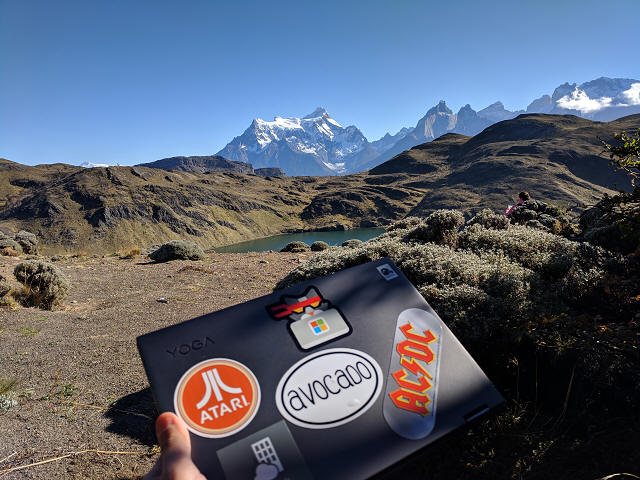
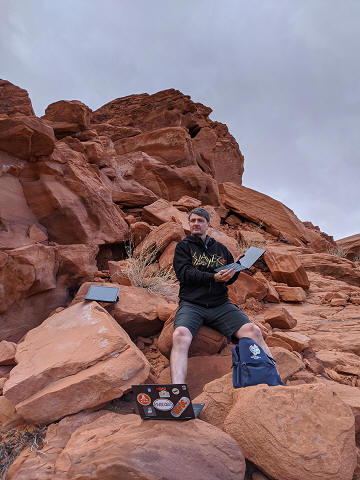
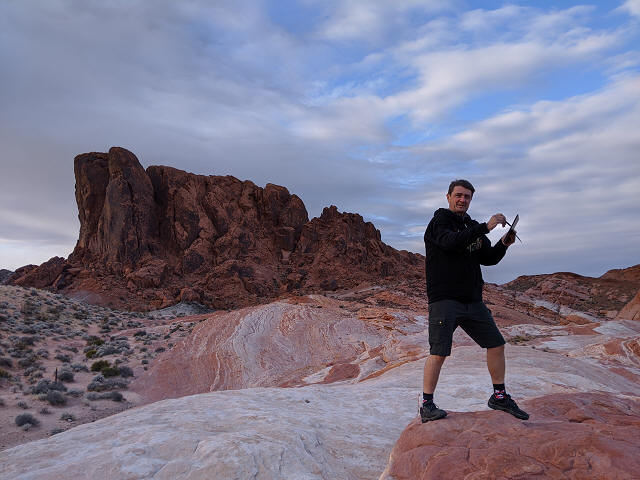
above: the ARM64-based Lenovo Yoga C630, my favorite laptop computer of 2018 to the present, visiting Patagonia in April 2019, hiking with the Yoga and Surface Pro X in Fire Valley November 2019.
photo credits: Janelle Poole
Telecomm and Television - Cutting the Cord
By the way kudos to Google for their Google Fi data plan, it's what makes these ARM64 devices usable in every country I've been. I have a Google Fi data SIM plugged in to every one of these devices and get charged a flat rate regardless of whether I'm in Mexico, France, Canada, Chile, or right here home in Seattle.
That's another disruptive technology that has snuck up on me and completely changed how I watch television and access the internet. Up until a year ago my smartphone used an AT&T data and calling plan which had been grandfathered in for the 20 years or so I've been on AT&T. My data plan was unlimited within the United States but boy did I get slammed with massive data and roaming charges every time I drove up to Vancouver or went overseas. My friend Steven Noonan made me aware of Google Fi and since I switched over my monthly cell phone bill has dropped in half, from over 90 dollars on AT&T with roaming charges to about 40 dollars on Fi.
I also realized why do I even have a land line phone in the house? I never use it! The only messages on it ever were telemarketers. It's one of things I never thought about, I've had a land line for 30 years never thought about disconnecting it. Yet that was about 50 dollars per month going to Centurylink for no good reason. And with it I realized I had an AT&T long-distance calling plan that I never used, so that was another almost 50 dollars per months being wasted.
Thanks to Steven waking me up to how I was wasting money on my phones, I looked at my television usage. Since 1995 I have been a DirecTV satellite subscriber, every few years having the technician come out and bolt on a newer larger dish and wire up a newer better receiver. I've lost track of how many DirecTV devices I've gone through in 25 years, at least 4 different dishes that I can remember, and maybe a half dozen receivers? There was the original round dish and receiver. Then when Tivo became a thing they upgraded that to an HDR recording receiver. The a high definition receiver. Then a dual-input high definition receiver. Then another with higher disk storage. The the multi-room one, and finally the 5-channel recording one.
Over the years I had coax cables going through the wall, under the floor, outside the window.
And then one day about a year ago we wanted to watch The Handmaid's Tale to see what all the fuss was about. DirecTV didn't have it. They had HBO, Cinemax, Starz, 500 channels of networks, but no Hulu which produced Handmaid. So fine, I created a Hulu account. I used the ASUS Novago ARM64 laptop to stream to my living room television since the ASUS had a full size HDMI port to output on. We watched all the seasons of Handmaid's Tale.
Then I realized something, doi, Hulu wasn't Netflix. Maybe I was slow, but I had never realized that besides their own content and syndicated television shows that Hulu also carried live local channels, HBO, and all the other networks I had on DirecTV. And Hulu allows 5 devices just like DirecTV. And yet I don't need to run coax cable, I just need an internet connection. This was a game changer to me, and maybe I was 10 year too late to "get" Hulu, but finally in 2019 I "got" Hulu. With the 5 device option, local channels, HBO, 200 hour recording storage, the Hulu bill added up about 100 dollars per month. My DirecTV bill, which I had not even looked at in years because it was set to auto-pay, was 257 dollar per month. _257_ dollars to watch television per months that I didn't even realize I was paying. In 1995 I think the monthly bill started at about 30 dollars before all the feature creep snuck up - DVR, HDTV, HBO, local channels, etc.
Within the course of a few weeks and switching providers to Google and Hulu, I got rid of a lot of wires and slashed my monthly phone and TV costs by about 300 dollars per month. 10 dollars per day I was wasting hanging on to dinosaur services I had signed up for in the 1990's and never questioned to change. In 1995 when I got DirecTV that _was_ cutting edge state-of-the-art technology. Back then Comcast sucked and I needed a land line for my 28.8 dial-up and fax machine. (wow, stop and think about the words I just typed. "dial-up", "fax machine").
1995 was 25 years ago - a generation ago. Satellite television and dial-up phone service is about as relevant in 2020 as vacuum tubes were in 1995.
Waking up and transforming your habits once in a while is a good thing.
Transportation - hybrid vs. all-electric
The next huge transformation that has begun is in transportation. Over the past decade we have seen cities convert their transit buses to electric. There has been growth in the sale of both hybrid-electric and all-electric vehicles such as the Toyota Prius, the Chevy Volt, the Nissan Leaf, and of course the various models of Tesla. I saw these on the roads but not knowing anything about them I assumed they were expensive and drove like crap.
My incentive to go electric began after a pair of costly repair bills in 2015, about $5000 to repair what was then a 20 year old Chevy Blazer, and a steep estimate to do some repairs on the 2005 Mustang. These cars were money pits and so I considered trading them in, thinking at first I'll buy a 2015 Mustange or perhaps one of the Ford Edge SUVs I'd driven in the past as a rental car and really enjoyed. I went to a couple of Ford dealers and found that I did not like the somewhat rounder more slender look of the 2015 Mustangs compared to my 2005 model. And the Edge (as is the case with most SUV models) had been sized up and was now larger than my Blazer and priced at over $40,000 with similar 18 mpg city EPA rating as what I was getting on the Blazer.
The Blazer was eating through gasoline at a cost of about 60 dollars per tank to go barely 300 miles. 20 cents per gallon in fuel costs on top of the costly repair bills and regular oil changes. I didn't need a larger SUV or a more girlie looking Mustang so I asked what else they had. And by luck (and because they were forced by law to sell them and were desperate to have one drive off the lot) the salesman suggested I try the Ford Focus Electric. It was a smaller car than the Mustang, with a small back seat and even smaller trunk. (Then again, the back seat of the Mustang is almost non-existent).
I took it for a test drive on the I-405 interstate and some side streets and immediately noticed three things - the car was almost silent, the acceleration was smoother than any car I'd experienced, and for a small car it had very peppy acceleration. This was my introduction to electric cars. I understood now what my Tesla driving friends meant by the car seems to accelerate before you even step on the pedal. An electric motor has instant torque. There is no lag as with a gasoline engine as far as needing to inject more fuel and more air into the engine, for the engine to rev up. Like the motor of an electric saw, an electric accelerates instantly. This Focus accelerated better than my Mustang! it didn't go as fast top speed or have the range, but for city driving this was great. I was using the Blazer mainly to drive the dogs around to daycare and to parks and to haul bags of dog food. This was large enough for that.
The financial incentive was also attractive. with a trade-in on the Blazer my total cost to drive the Focus off the lot was a small down payment and a 205 dollar per month lease for 36 months. One great factor was that for the lease they took the $7500 federal tax credit off the cost of the lease, and since Washington state charges no sales tax for electric vehicles, there was no tax. Zero.
Once I got it home and plugged in the charger to my home outlet I found that to "fill up" the 50 miles of range took about 18 kilowatt hours of electricity. That's about 2 dollars per day at what we pay in Washington state. Obviously if I drove only 25 miles in a day that would only cost a dollar. So basically "cost of fuel" for the Focus was 4 cents per mile for city driving and 5 cents per mile for highway driving (due to more drag). Compare that to the 20 cents per mile for the Blazer and similar for the Mustang.
In general each mile driven electric costs about (depending on the local price of gasoline, electricity, and the vehicle) about 1/2 to 1/5th the cost of gasoline.
Over the course of the three years I leased the Focus I drove it just over 20000 miles at an overall cost of about 60 cents per mile. That's total, the lease and the electric "fuel". I paid zero in taxes. I paid zero for repairs because in three years the Focus required zero dealer visits and thus zero repairs. The only maintenance I had to do was to put air into the tires once a year, clean the windshield, and I did swap out the low-voltage battery on the advice of the internet because the stock battery that Ford used tended to drain when not in use.
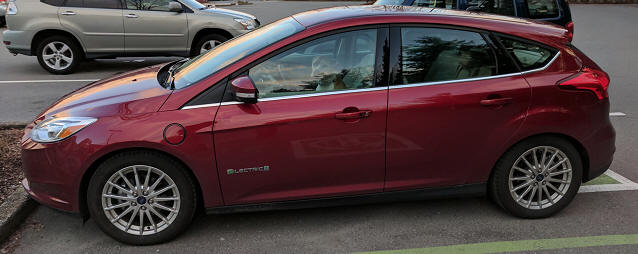
above: my Ford Focus Electric
The one expression I quickly learned driving the Focus is "range anxiety". Oh boy did I suffer a lot of range anxiety at first. When you consider that first-generation electric cars such as the Ford Focus Electric and the Nissan Leaf had a 50-mile range at best, total, 50, that is like driving a gasoline car with the dashboard light telling you you are low on fuel. 50 miles seems like a lot but even just driving around town that adds up quickly. A round trip to Sea-Tac airport and back is about 40 miles, and if you drive on the I-5 freeway at high speed the drain on the battery is higher. I found out the hard way first time I dropped someone off at the airport that I couldn't get back home because at highway speeds the range was just under 40 miles. I had to quickly get online and find a charging station 2 miles from home because I literally would have not made those last two miles.
In 2015 the availability of charging stations was small, you really had to plan out your trip. In 2020, even though I no longer have the Focus, it is much easier.
Most large companies, high schools, libraries, city halls, now have at least the L2 charging stations which are common plugs that can be used by any Tesla, the BMW i3, the Leaf, the Focus, Audi e-Tron, the Kia Niro. These provide charging at up to 6 kilowatt-hours which for these cars will replenish about 13 to 20 miles of range per hour, or about 3 to 4 hours to completely "fill up the tank".
Note that batteries remain a constant weight, so battery empty or battery full the car is the same weight. Unlike gasoline where filling up that 18 gallon tank adds over 100 pounds of fuel to the car's weight.
I still hated the range anxiety so I eventually replaced the Ford Mustang with a leased 2018 Chevy Volt. As with the Focus, the Volt has about a 40- to 50-mile electric range in Seattle weather, about 10 miles less due to a smaller battery. That's because the Volt is a PHEV (plug-in hybrid electriv vehicle). In addition to the battery the car contains an actual gas tank and a gasoline engine. But unlike a conventional gasoline motor, the engine never directly mechanically connects to the wheels. The gasoline engine is there to charge the battery only. The drivetrain of the car is still purely electric motor. The gasoline engine spins and powers one motor which acts as a giant alternator, which then charges the battery which in turns powers a large electric motor which turns the wheels.
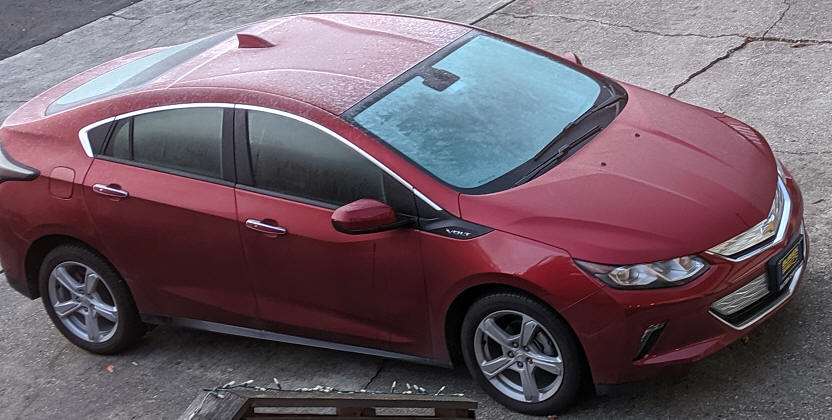
above: my Chevy Volt
In over 2 years of driving the Volt I have only had to fill the gas tank (a rather small tank of about 8 gallons) three times. Out of about 10000 miles driven about 9000 have been electric, about 1000 on gasoline for when I needed to exceed the 50-mile range. What I have found experimentally by, for example, driving to and from the airport purely on gasoline, is that the "gasoline charges battery, battery turns electric motor" approach works well. it is possible to drive at highway speeds and still get over 40 miles per gallon gasoline efficiency. This is about TWICE the efficiency of my old Ford Mustang or Chevy Blazer thanks to the fact that regenerative breaking stores energy which can then be used for acceleration.
The important distinction between a purely gasoline engine based drivetrain and the Chevy Volt approach is that the RPM of the gasoline engine is uncoupled from the actual speed of the car. The gasoline engine can thus run at an optimal constant RPM to charge the battery irrelevant of how fast or how slow the car is moving. Since the electric motor still provides the instant torque for accelerator, there is no lag when you press on the pedal like a purely gasoline car.
Ok now let's take a different look at an older approach to hybrid.
My wife has a Toyota RAV4 Hybrid which we've used as our SUV. RAV4 is based on the Toyota approach to hybrid drivetrains. They don't use the gasoline engine as a battery charger, rather they have a transmission that essentially combines the gasoline engine and the electric motor to the same shaft that drives the wheels. It is also not a PHEV plug-in hybrid that you charge through a wall outlet. Rather, the regenerative energy of the brakes charges the battery as does the gasoline engine. i.e. the car has to be running to charge the battery.
This is a different approach, as it also requires that at speed about about 40 miles-per-hour or 65 kilometers per hour the gasoline engine always kicks in. The electric motor itself and the small size of the battery make continuous highway driving impossible in just electric mode. Unlike the Ford Focus Electric or the Chevy Volt, you cannot drive the RAV4 on the highway without burning gasoline.
Toyota advertises at 40 mile-per-gallon range of our RAV4, but in reality I'm sad to say both city driving and highway driving the lifetime efficiency of the car so far is only 33 miles per gallon. I am finding it next to impossible to sustain electric-only driving for more than a few blocks at a time. If I stop at a light and press on the accelerator too fast the gasoline engine kicks in. If I get on anything faster than local residential road the gasoline engine kicks in.
I have compared my mileage with a friend's almost identical but non-hybrid RAV4 and the hybrid / not-hybrid range different is only about 1 to 2 miles per gallon.
Again, doing this same experiment with Volt or forcing the gasoline engine on I always easily get over 40 miles per gallon.
So I'm not sure why Toyota went the approach they did? Perhaps it is cheaper to manufacture and maintain their transmission vs. Chevy's approach. Perhaps (and it seems so) that not believe in electric drive trains. Perhaps it is a slightly higher curb weight of the RAV4 compared to the Volt and I should really be doing this experiment on a Prius, but to me Chevy seems to have the better technology.
You the reader can decide. There is a fantastic set of YouTube videos on the WeberAuto channel that describes the distrinction between Chevy Volt and Toyota approaches to hybrid drive trains:
https://www.youtube.com/watch?v=dqM3YXEf1js
https://www.youtube.com/watch?v=dLNDGUISTYM
Now, before you dismiss Toyota's technology or hybrid cars in general, let me give you the reason why we need it and why we cannot shut off all oil production overnight: RANGE.
First-generation electrics such as the Leaf and Focus and i3 are great if you need travel under 50 miles per day and can leave the car charging over night. They're city cars only, glorified golf carts!
The plug-in hybrids such as Kia Niro and Chevy Volt give the best of both worlds, range in the hundreds of miles if you are willing to burn mostly gasoline. I've never tried to do it in one shot but based on say 40 miles per gallon, 8 gallons, plus 50 miles electric the Volt could in theory travel 370 miles without a re-fuel/re-charge. That is about exactly the same 370 mile range I consistently get with the RAV4, and that's a larger heavier vehicle with more room and storage.
So if you were taking the family on a road trip, say 1000 miles or more, both the Volt and the RAV4 would need 3 hops, 3 fuelings. But unless you stopped for at least 4 hours to charge the Volt's battery, your range is actually 370 + 320 + 320 = 1010 miles. You would _barely_ make it without either experiencing range anxiety or stopping to fuel for a 4th time. The RAV4 would easily go 1110 miles. A 100 mile diffence. If you were driving cross-country and say had to go New York to L.A. say 3000 miles you'd be looking at more stops, more times, a more cramped car if you took the Volt.
That is why for example this past November when I needed to drive 280 miles to Spokane for the Primus and Slayer concert at Spokane arena, taking the RAV4 was a no-brainer. It was raining in Seattle, snowing in the mountains, I was driving with my friend and fellow heavy metal mosh pit vegan Nataliya. We wanted to minimize the round-trip time because it was a Sunday night and we each needed to be at work on Monday morning. The RAV4 did great, it handled the snowstorm, it needed just one extra fill up leaving Spokane.
And this is the reality of people doing long drives. Electric cars are great for city driving, they reduce pollution, they cost little to maintain. But realistically to go between cities, to take the family on a road trip (once that is legal again!) is not practical unless you're willing to spend a lot of time stopping at charging stations. Which as I found out are still far and few between.
Tesla has set up a network of high-speed charging stations on major highways in Canada and the United States. Those chargers don't work with most non-Tesla cars.
What the rest of us get is a network of various brands of "L2" (the 6 kW/h charger) and "DC Fast Charge" (newer 50 kw/h to 350 kW/h) charging stations which require memberships in Chargepoint, Greenlots, EVGO, and other providers.
The situation is not ideal yet for non-Tesla cross-country EV travel.
That is changing.
As I said before I was thrilled to see no fewer than 4 electric vehicle ads on the Superbowl. One of them was the new electric Hummer, another the Audi e-Tron.
Audi is owned by Volkswagen, the company that cheated on their emissions tests, but also the company setting up a network of Electrify America DC Fast Charge charging stations for us non-Tesla drivers.
The e-Tron is called the "anti-Tesla" because it is a giant 2900 kilogram 3-ton German tank that one driving magazine said has the worst electric car range of any electric car on the market. It stands for the complete opposite of what the geek boys who buy a Tesla Model 3 and brag about getting over 4 miles per kW/h when they hyper mile and drive like old ladies.
The e-Tron does not look like an EV. It lacks the funky sharp angles of the Prius, the round bubble shape of the BMW i3 or Leaf, the plain boring soap bar look of a Model 3. The e-Tron looks like a normal SUV, such as a Q5 or a Macan. It has a big fake radiator grill in the front for no practical reason. It blends in, it doesn't scream out "look at me I'm a nerd driving an EV".
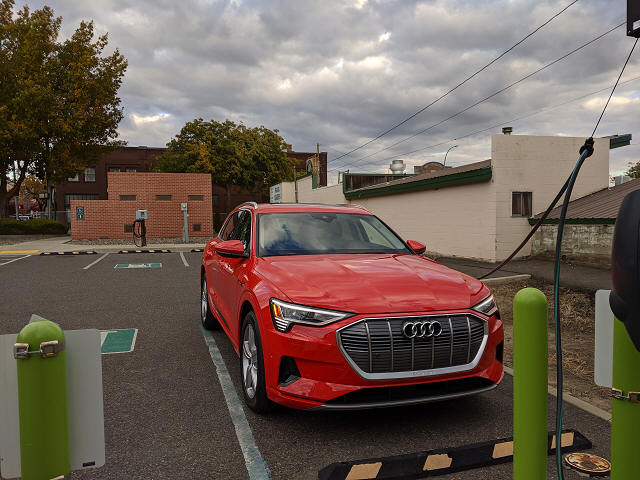
This might be the hook that is needed to get the 95% of drivers not driving EV to switch to EV. Most people don't give a crap about the technology, they just need a car that works reliably and doesn't look embarassing.
They falsely believe EV cars or hybrid cars cost more. My experience with the Ford Focus Electric and even the Volt says otherwise, because you save on taxes, you save on fuel. And most importantly you save on a whole series of repair and maintenance costs. The Focus cost me 100 dollar for a new battery in 3 years of use. The Volt so far has require once single oil change in almost 3 years. I've gone to the gasoline pump 3 times to fill the Volt in almost 3 years. I don't deal with muffle shops, radiator shops, transmission shops, etc. Other than oil changes maintenance is practically a non-issue with electric cars.
When more of us are driving electric this will disrupt the automobile maintenance industry. Who needs a muffler when the car is silent?
But unfortunately the average buying consumer does not look at the lifetime cost of ownership, they just look at the price to drive the car off the lot. And this is why just to sell a car Ford to practically give away the Focus.
That used to be case with pickup trucks. 30 years ago when minivans were all the range, and F-150 or S10 pickup truck was cheaper than a cheap car. That changed with marketing and convincing Americans that pickup trucks were cool. Now companies like Ford and Chevy are moving most of their gasoline vehicle production to pickup trucks and charging a premium for them.
Reflect on the past. Those of you who have seen the excellent movie "Ford v. Ferrari" learned (as I did) that Lee Iacocca originally helped develop the Ford Mustang in the 1960's and its image as a muscle car. I only knew him from the 1980's at Chrysler, when after the 1970's OPEC oil embargo car companies started product small crappy fuel-efficient cars. He took Chrysler the other way, he popularized the minivan, the large spacious inefficient means of transporting a single Starbucks coffee and a single bag of groceries. He understood how Americans think. Americans want big and convenient, not small and practical.
Which is why I think the hook and the strategy of the e-Tron, the electric Hummer, the new electric Mustang SUV will be the tipping point. To make EV's popular they have to be roomy, have long range, and be large to hold the massive batteries to give you that range. You can't fill up the trunk with batteries as Ford did with the Focus. So you can't take what little space the Mustang had and fill it with batteries, you have to grow the Mustang itself. For the average American it's not going to be about maximum range per kW/h or minimizing the total lifetime cost, but it will get EV cars rolling off the lot.
That's the tactic Tesla used - target the high-end market of geeks to get the cars selling, then use that profit to create a production line of cheaper Model 3 cars which can only work at mass scale.
I recently charged my e-Tron at one of the new Electrify America charging stations that opened nearby. In fact this is it drinking some energy.
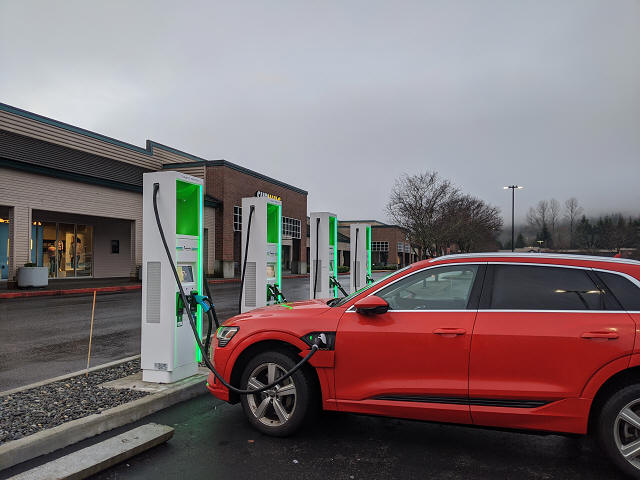
Let me give you some scale first.
The Volt and the Focus if I left them plugged in at home on the 120V wall outlet needed about 12 to 18 hours to fully charge. That's because wall outlets only provide about 1 kilowatt of charge rate. Go to a mall, to a business, any place that has an L2 charge and you charge 6 times faster. That charge time drops to 3 or 4 hours tops. But only for 50 miles of range.
Cars like the e-Tron or the Tesla have batteries that hold 90 kW/h or more, which would literally take 4 full days to charge at home or 15 hours at an L2 charging station. Who wants to spend 15 hours at the mall?
So the next step up - DC Fast Charge - provides about 50 kW/h of charge rate. That is what most of the DC stations I have found so far provide.
But Volkswagen's Electrify America stations provide up to 350 kW/h charge rate. The charger I used was a 150 kW/h charger and yes indeed in little over 30 minutes pulling in with about a 10% battery charge I full charged up the e-Tron and topped off about 170 miles of range. At a cost that was still a fraction of the cost of the comparable amount of gasoline.
That is the kind of charge rate that means to drive 1000 miles you should have to stop say 6 times, charge 3 hours total, at stations spaced about 150 miles, 250 kilometers, apart. 150 kW/h or faster DC Fast Charging means that driving cross country can be done in about the same amount of time as driving on gasoline, provided this infrastructure of chargers gets rolled out soon.
2020 is a game changer moment - EVs that appeal the American masses, the availability high speed charging, the plausibility of long purely-electric road trips, and the eventual elimination of many of the maintenance costs that have plagued automobiles for the past century and kept the price of car ownership high.
The evolution of complex mechanical gasoline cars to electric vehicles is analogous to the switch from incandescent light bulbs to LEDs, the switch from mechanical rotating spindles to flash memory.
Giving up meat.
I am going to stop for today and let you absorb what I've said so far. Giving up meat, that was the final major transformation in my life this past decade and I will not lie, it was the most difficult. Switch to SSD and LED and ARM64 and EVs is a no-brainer to a math nerd. The benefits and savings and convenience of each is plainly obvious.
But I spent the first 50 years of my life eating steak and bacon and hot dogs and burgers. Everything about the concept of giving up meat went against the younger me that once drove a Ford Mustang.
And it was difficult, I tried it several times and gave up on giving up meat. So how did I finally succeed? Burger King making the Impossible Whopper mainstream certainly helped. Realizing that being vegan does not mean just eating lettuce salads and that many of my favorite dishes were already vegan or could be adapted was really the gateway. Stay tuned...
Comments, questions? Let me know at emulators@emulators.com and regardless - KEEP STAYING AT HOME!
[Part 42-A] [Table Of Contents] [Return to Emulators.com]